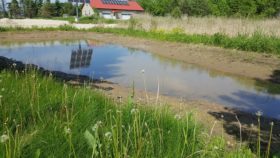 Metamorphosis is taking place all over Crossroads this week. The tadpoles in our new bio-detention pond are growing legs, and already tiny frogs (or maybe toads—too little to see markings) are popping like popcorn near our wetlands. Butterflies and moths are emerging. And oh yes… our parking lot is changing.
Metamorphosis is taking place all over Crossroads this week. The tadpoles in our new bio-detention pond are growing legs, and already tiny frogs (or maybe toads—too little to see markings) are popping like popcorn near our wetlands. Butterflies and moths are emerging. And oh yes… our parking lot is changing.A few years back while hiking with fifth grade students, I heard a couple of very excited boys explaining to their classmates that two caterpillars were mating. I usually am reluctant to contradict children, but in this case, I just had to explain that caterpillars are immature and incapable of mating. Only after they go through metamorphosis and become flying insects can moths reproduce.
Caterpillars have essentially one job. They eat.
The adult male moths have essentially one job—they mate with females. The females have (oh, wow) two jobs. They must mate and then lay eggs.
Caterpillars can’t mate and the adult moths can’t eat. Amazing but true. So when the kids saw two caterpillars together, I could assure them that the immature moths were not “doing anything” because caterpillars do not have the organs which make mating possible.
Moth caterpillars are simply eating machines. Maybe I shouldn’t say simply. They are not hollow tubes waiting to be stuffed. They are complicated and fascinating creatures, complete with three body parts (head, thorax, and abdomen) and filled with internal organs. They have eyes, and antennae and special mouthparts for biting and jaws for chewing.
Most caterpillars have six legs like other insects, and also two to five pairs of funny little suction cup-like appendages called prolegs.
They are very complex creatures. BUT, when you think about it, all of the parts of the caterpillar are for finding, reaching, eating and digesting food. That’s what they do. And they do it well.
Once the caterpillar is wrapped in the cocoon, amazing changes take place. The body cells rearrange themselves. When the adult moth emerges, it has wings and sexual organs—both of which are needed for mating. Weather…temperature and moisture…… influence the time it takes for metamorphosis to occur and during this transitional period, if the cocoon is bumped or if it falls to the ground, the moth will not develop properly.
When they became adults, moths cannot bite, they cannot chew, they cannot eat. True, they visit flowers and sip nectar, but that is sort of like sipping a sugary drink. It gives the moths liquids and quick energy—but all of the nutrients plus vitamins and minerals the moth needs, they consumed as caterpillars.
Expanding and upgrading our parking lot has been rather like the life cycle of a moth. Just as caterpillars must voraciously eat to acquire the energy required for metamorphosis and its adult life, Crossroads had to aggressively raise the funds for the engineering, materials, and the construction costs. And as a caterpillar needs to consume all of the nutrition a moth will need to breed, we had acquired the full sum for the parking lot before we started.
Planning and engineering resembled the time the caterpillar is in the cocoons. Progress was not visible, but lots of arranging and changing was going on and the final outcome was being determined.
Hopefully, over the next couple weeks our parking lot metamorphosis will take place. As a cocoon should not be disturbed, getting in the way during the upcoming construction will not be helpful. Of course, temperature and moisture influence progress in any construct project — and we have had quite a bit more moisture than anticipated during the last few weeks. But we will hope for good weather and for the next couple weeks, we have scheduled no large events. Parking will be available much of the time, but when heavy equipment is present, we ask that visitors park in the Maintenance Building or at the Astronomy Campus parking lot.
Crossroads at Big Creek is made up of three properties, Ida Bay, The Cove, and the Big Creek Preserves. The Collins Learning Center, located at 2041 Michigan Street is open 1:00-3:00 Tuesday-Saturday during the summer. Restrooms and trails are always open.

